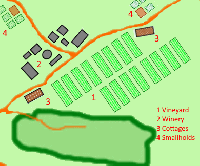Table of Contents
Outpost
General
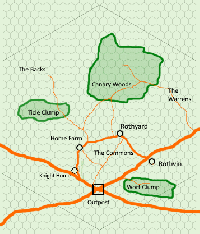 Outpost is a heavily developed rural area, that is home to the Midmarch Army. Their commander, Sir Borric lives just outside the village, and the the Garrison oversees troop deployment around the area. As well as Sir Borric's holdings, there are three large farms and many small holdings. In population terms, the hex has as many residents as some towns in the area - however, the population is spread across the area, rather than concentrated in an urban setting.
Outpost is a heavily developed rural area, that is home to the Midmarch Army. Their commander, Sir Borric lives just outside the village, and the the Garrison oversees troop deployment around the area. As well as Sir Borric's holdings, there are three large farms and many small holdings. In population terms, the hex has as many residents as some towns in the area - however, the population is spread across the area, rather than concentrated in an urban setting.
The area is good agricultural land, and uncultivated areas are mainly rough grass land, bumpy and uneven, with small clumps of bushes breaking the boring green sea. There are small hills, dips and valleys and there are a lot of small streams – although nothing that needs any effort to cross over. Small copses / thickets of two to six trees are not uncommon. The main plants are horse grass, stink weed with occasional clumps of wild kale – along with a selection of wild flowers. The thickets are composed of low trees and bushes, which often include crab apples, green plum, blackberry and cloudberry. At the right time of year you can find ramsoms and fields of bluebells.
Most of the residents live close to the village or hamlets, although you may occasionally encounter hunters, trappers or woodsmen in the other areas.
No change Jan 2023
Outpost Village
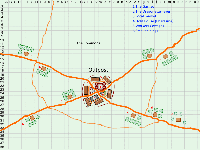 Outpost is a well-developed military/agricultural village, one of the few defended by a palisade, and dominates the surrounding area. There is a large a military garrison, a tavern, a market square and a Holy House dedicated to Pharasma. It is surrounded by farms and smallholdings.
Outpost is a well-developed military/agricultural village, one of the few defended by a palisade, and dominates the surrounding area. There is a large a military garrison, a tavern, a market square and a Holy House dedicated to Pharasma. It is surrounded by farms and smallholdings.
- The Garrison: Has a solid wooden palisade enclosing the garrison buildings. The soldiers here provide protection for the Village and Hamlets but occasionally patrol up to twenty or thirty miles away. They also make occasional patrols into adjoining hexes. Lt Cdr Ress acts as Bailiff, and is both the Viscount’s representative and local magistrate. He is also responsible for troop deployment at Oston, Junction and Bar-Z – so he is a busy man. Inside the palisade, wooden buildings provide barracks for the soldiers, and a small house for the commander – as well as stables, kitchens and a common room etc. Notes
- Pharasma's House: A small religious house, surrounded by a neatly tended area with a few graves. It falls under the watchful eye of a junior Pharasmin priest, Brother Amos, along with his acolyte and a couple of dedicated labourers.
- The Market: Little more than an open square, set aside for local people to trade. Occasionally a mule train comes through, and more exotic goods are on sale – but generally it offers, firewood, eggs, home-made items such as jam, cheese, simple furniture, pies and other similar items.
- The Dragonet: This local tavern is associated with the Roth family. It has links with the Dragons' Den Inn and Roths Brewery in Tusk, as well as the Rothyard hop farm.
West Farm
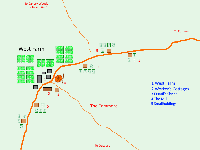 Part of the Viscount’s estates this hamlet has had problems, in the past, but it now a model of Good Behaviour.
Part of the Viscount’s estates this hamlet has had problems, in the past, but it now a model of Good Behaviour.
- The Farm - grows cereals as a cash crop – mainly wheat but barley and oats as well. Unlike the smallholdings it has a large barn for storing grains as well as oxen and a couple of ploughs for clearing the fields. There is a house for the farmer and a small row of cottages for the people who work there. It also provides casual work for the smallholding families, at busy times of the year. However, it also keeps a few cows, pigs and other farm animals (often grazing them on The Commons) and grows vegetables in smaller fields (cabbage, turnip, peas, onion, beans and other staples as well).
- The Mill - Grinds all the corn for the area, including that from the farm and any of the smallholdings that grow grains.
- Ersatil's Shrine - is home to an acolyte of Fiddler, the Priest of Oston. He keeps a wary eye out for signs of unusual religious practices or other odd behaviour.
There are few smallholdings (see below for description) scattered around close to the farm.
Rothyard
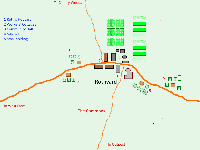 This hamlet provides the special hops that the Roth Brewery in Tusk needs to produce their premium ale, Poachers Pale.
This hamlet provides the special hops that the Roth Brewery in Tusk needs to produce their premium ale, Poachers Pale.
- The Hop Yard - is similar to a normal farm, that has a small mixed agricultural section, although its main cash crops are barley and hops. There is also a small oast house for drying and preparing the hops ready for use. The hops and barley are sent to the Roth Brewery in Tusk, where they are used to make Poacher’s Pale Ale.
- The Community Hall - provides a communal area for the Roths' workers and other locals to meet and trade. It also hosts communal celebrations.
- Villa Roth - A small fortified home for the Roth family, when they want a trip to the country.
There are a few smallholdings (see below for description) scattered around close to the farm.
Rothvin
This hamlet grows grapes that the Roths needs to produce their signature wine, 'Grapes of Roth'.
- The Vinyard - is similar to a normal farm, there is a small mixed agricultural section, although its main cash crop is grapes. There is also a small pressing area, to produce the grape juice used to make wine.
- Grapes of Roth - The winery which makes the eponymous wine.
There are a few smallholdings (see below for description) scattered around close to the farm.
Knighthome
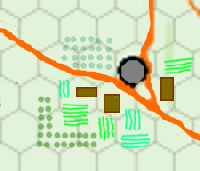 This hamlet is home to Sir Borric, Chief Magistrate of Midmarch.
This hamlet is home to Sir Borric, Chief Magistrate of Midmarch.
The Manor consist of a large circular tower, in the form of a Shell Keep. The outer walls surround a well-appointed apartment for Borric and barracks for his personal troops, as well as kitchens, stables and other ancilliary buildings.
The Farm grows all the normal crops, but is surrounded by orchards for both apples and plums.
A few smallholdings (see below) are scattered about the area.
The Smallholdings
No two are quite the same, of course, but they are the lifeblood of the rural community. Small and well spaced out, each small holder has a herb garden, chickens and a few plots growing vegetables, most commonly cabbage, turnip, onion and peas. They may have a couple of goats grazing on the common as well. However, that doesn’t provide much more that a subsistence living for the extended families who live in the small holdings - so they supplement their incomes in other ways. Most work as occasional labourers, either on farms or maintaining the local roads, while some have had a family member who works at the garrison. Others have minor skills - such as carpenter, smith, potter or trapper – and they make many of the rustic items on sale in the market. (Note that these are very low skilled crafters and can only make, or repair, simple items)
The Backs
One of the least cultivated areas, it is very similar to the general terrain, but the ground is rockier and broken with more thickets and kale. It is more difficult to travel across than the rest of the area. It is a good area to hunt for wild grouse and pigeons.
The Warrens
Dry, sandy ground, that is riddled with rabbit and ground squirrel warrens. Steep banks and cuts mark the area out, along with many small clumps of kale and fruit bushes. Most households have a member who is licenced to trap here, although there are resections on how many animals a trapper may take in a week.
The Woodlands
Canary Woods, Ticle Clump and Wort Clump are a source of building and fire wood. These are open woodlands composed of mainly of beech trees with the occasional oak and rushleaf. On the margins you will find crab apples, green plum, blackberry and cloudberry and, at the right time of year, ramsoms and fields of bluebells. Small animals such as badgers, squirrels are common, as are small herd of shaggy deerling. Canary Woods is reputed to be home to packs of thylacines and many giant insects.
The Commons
Much like the general terrain of the area, but grazed into better shape, The Common serve as a grazing ground for most of the residents. You will find cows, goats, sheep, ponies, donkeys, mules etc - in small herds or staked out to graze in a restricted area. You may well encounter herders and husbandmen guarding their herds and looking after the animals.
